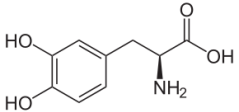Project
MSc - Bio-inspired polymers used as adhesives
The intertidal marine species, e.g. mussels and sandworms, are known to have a unique ability to attach to all types of wet substrates (e.g. rocks) and maintain adhesion under very harsh environment, i.e. turbulent waves.

The natural ‘superglue’ secreted by these organisms are a mixture of proteins. These proteins are identified to share a common characteristic that they all have a certain amount of 3, 4-Dihydroxyphenylalanine (DOPA) (figure 1). The central role of DOPA in bio-adhesion is significant in two ways: firstly, catechol groups in DOPA can facilitate adhesion to various substrates via hydrogen bonding, π-π aromatic interactions and metal-ligand complexation; secondly, crosslinking of DOPA via oxidative, enzymatic or redox induced radical chemistry can lead to the solidification of the precursor proteins.
The aim of this MSc thesis project is to mimic the unique adhesive properties of mussels by preparing synthetic polymers bearing DOPA functionality. In this project, we will carry out polymer synthesis in different ways, and study the influence on the mechanical properties of the polymers.